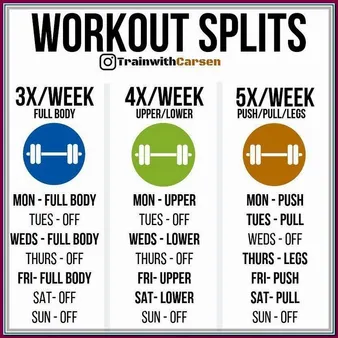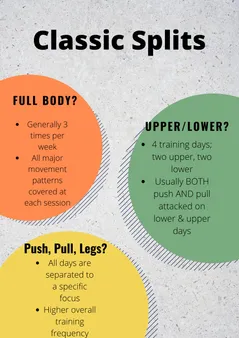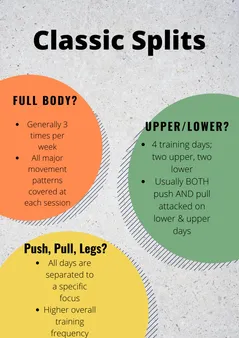Table of Contents
Calisthenics is a great way to get in shape without having to go to the gym. It's a bodyweight training method that uses exercises like push-ups, pull-ups, and squats to build strength, endurance, and flexibility. If you're new to calisthenics, starting with a split routine can be a great way to ease into it and avoid burnout. A calisthenics split is simply a way of dividing your workouts into different days of the week, focusing on different muscle groups each day. This can help you to recover more quickly and make progress more efficiently. On Kizworld, we have a variety of calisthenics split routines that you can follow, depending on your fitness level and goals.
The Ultimate Calisthenics Split: A Comprehensive Guide to Building Muscle and Strength
Calisthenics Split Type | Focus | Frequency | Duration |
|---|---|---|---|
Upper/Lower Split | Upper body one day, lower body the next | 3-4 days per week | 45-60 minutes per session |
Push/Pull Split | Pushing exercises one day, pulling exercises the next | 3-4 days per week | 45-60 minutes per session |
Full-Body Split | All muscle groups in one session | 2-3 days per week | 60-90 minutes per session |
I. Calisthenics Split: Understanding the Fundamentals
Benefits of a Calisthenics Split
Calisthenics splits offer numerous benefits for individuals looking to enhance their fitness. By dividing calisthenics workouts into specific muscle groups or movement patterns, individuals can reap the following benefits:- **Increased Strength and Muscle Mass**: Focusing on isolated muscle groups allows for heavier loading, leading to increased strength gains and muscle hypertrophy.- **Improved Efficiency**: Splitting workouts enables individuals to allocate more time and energy to each muscle group, resulting in more efficient and productive training sessions.- **Reduced Risk of Overtraining**: By distributing the workload across multiple sessions, calisthenics splits help prevent excessive stress on the body, reducing the risk of overtraining and injuries.Read more: How to Design Your Own Calisthenics Routine and Program
Calisthenics Split | Focus | Benefits |
|---|---|---|
Upper/Lower Split | Upper body one day, lower body the next | Improved strength and muscle mass in both upper and lower body |
Push/Pull Split | Pushing exercises one day, pulling exercises the next | Balanced development of pushing and pulling muscles |
Full-Body Split | All muscle groups in one session | Increased efficiency and time-saving |
Choosing the Right Calisthenics Split
Selecting the best calisthenics split depends on individual goals, experience, and recovery abilities. Here are some factors to consider:- **Fitness Level**: Beginners may benefit from a full-body split with 2-3 sessions per week, while advanced individuals may prefer more specialized splits with higher workout frequency.- **Time Availability**: Those with limited time may opt for a full-body split or an upper/lower split, while those with more time can explore advanced splits like push/pull or other variations.- **Recovery Capacity**: Training intensity and volume can impact recovery needs. Individuals with good recovery abilities can sustain higher training frequencies, while those with limited recovery may benefit from more rest days between workouts.
Read more: The Most Common Calisthenics Mistakes & How to Fix Them
Calisthenics Split: Understanding the Fundamentals
II. Designing a Calisthenics Split for Optimal Results
Train Different Muscle Groups on Separate Days
To optimize your calisthenics split, consider training different muscle groups on separate days. This strategy allows each muscle group to fully recover before the next workout. For instance, you could dedicate one day to upper body exercises like push-ups, pull-ups, and rows, and another day to lower body movements such as squats, lunges, and calf raises.
By training different muscle groups on different days, you give your muscles adequate time to rest and repair, promoting optimal muscle growth and strength development. This approach also helps reduce the risk of overtraining and potential injuries.
Consider Your Fitness Goals and Experience Level
When designing your calisthenics split, consider your specific fitness goals and experience level. If you're a beginner, starting with a full-body workout routine 2-3 days per week can be a great way to build a solid foundation. As you progress, you may want to switch to a more advanced split that targets specific muscle groups.
For intermediate to advanced calisthenics practitioners, a split routine that targets different muscle groups on separate days can be more beneficial. This strategy allows for greater focus on each muscle group and can help you achieve more significant results.
Example Calisthenics Split for Beginners
Monday: Full-body workout (push-ups, pull-ups, squats, lunges, calf raises)
Wednesday: Rest
Friday: Full-body workout (push-ups, pull-ups, squats, lunges, calf raises)
Example Calisthenics Split for Intermediate to Advanced Practitioners
Monday: Upper body (push-ups, pull-ups, rows, dips)
Tuesday: Rest
Wednesday: Lower body (squats, lunges, calf raises, hamstring curls)
Thursday: Rest
Friday: Core and flexibility (planks, bridges, stretching)
Saturday: Rest
Sunday: Active recovery (light cardio, yoga, walking)
Tips for Adjusting Your Calisthenics Split
As you progress in your calisthenics journey, you may need to adjust your split to better meet your needs. Here are a few tips:
- Listen to your body: Pay attention to how your body responds to different splits and adjust accordingly.
- Experiment with different splits: Try out various splits to find the one that works best for you.
- Consider your schedule: Make sure your split fits your schedule and lifestyle.
- Don't be afraid to ask for help: Consult with a qualified fitness professional or calisthenics coach for personalized guidance.
Designing a Calisthenics Split for Optimal Results
III. Advanced Calisthenics Split for Enhanced Performance
Periodization and Progression
Periodization is an essential aspect of any advanced calisthenics split. It involves varying the intensity, volume, and frequency of your workouts over time to allow for optimal recovery and progress. This can be done by incorporating different types of splits, such as upper/lower splits, push/pull splits, or full-body splits. By manipulating these variables, you can maximize muscle growth, strength gains, and overall performance. For instance, if you're aiming to improve your upper body strength, you might incorporate a higher intensity upper body day into your split and gradually increase the weight or resistance you're working with over time.
Skill-Based Training
In addition to strength training, advanced calisthenics training often incorporates skill-based training, such as planche, front lever, and muscle-ups. These exercises require a high level of coordination, strength, and flexibility, and can greatly enhance your overall fitness and movement capabilities. Skill-based training typically involves practicing these movements with various progressions and variations to gradually increase your skill and strength levels over time.
Recovery and Nutrition
Recovery is paramount for advanced calisthenics training. This involves getting adequate sleep, hydration, and nutrition to support muscle growth and repair. It also involves incorporating rest days into your split to allow your muscles to recover and rebuild. Nutrition plays a crucial role in providing your body with the necessary nutrients to support your training and recovery. This includes consuming a balanced diet rich in protein, carbohydrates, and healthy fats, as well as staying adequately hydrated. Read our article on calisthenics progression to learn more about skill-based training and periodization.
Calisthenics Split Type | Focus | Frequency | Duration |
|---|---|---|---|
Upper/Lower Split | Upper body one day, lower body the next | 3-4 days per week | 45-60 minutes per session |
Push/Pull Split | Pushing exercises one day, pulling exercises the next | 3-4 days per week | 45-60 minutes per session |
Full-Body Split | All muscle groups in one session | 2-3 days per week | 60-90 minutes per session |
Advanced Calisthenics Variations
Advanced calisthenics workouts often incorporate variations of basic exercises to increase difficulty and challenge different muscle groups. These variations can include weighted exercises, such as weighted dips or pull-ups, as well as plyometric exercises like clap push-ups or box jumps. By incorporating advanced variations into your split, you can continue to challenge your muscles and progress your training. For example, you might incorporate weighted dips into your upper body day to increase the intensity of your chest and triceps workout.
Frequency and Intensity
The frequency and intensity of your advanced calisthenics split will vary depending on your individual fitness level and goals. Generally, advanced practitioners may train with a higher frequency and intensity compared to beginners. For instance, an advanced practitioner might train 4-5 days per week with a high intensity, while a beginner might train 2-3 days per week with a lower intensity. It's important to listen to your body and adjust your training accordingly to avoid overtraining or injury. Check out our article on calisthenics equipment to learn about the different types of equipment that can be used in advanced calisthenics training.
Stretching and Mobility
Stretching and mobility exercises are an important part of any calisthenics split. They help improve flexibility, prevent injuries, and enhance overall movement quality. Advanced calisthenics training often incorporates dynamic stretching and mobility drills into the warm-up to prepare the body for the workout. It's also important to incorporate stretching and mobility into your rest days to maintain flexibility and prevent muscle tightness. You can also read our article on calisthenics training to learn more about advanced variations and exercises.
Advanced Calisthenics Split for Enhanced Performance
IV. Troubleshooting and Optimizing Calisthenics Split for Maximum Progress
Finding the right calisthenics split for you can boost your results and progress. However, there might be times when you feel like you're not making the progress you expected or that you've hit a plateau. In these cases, troubleshooting your calisthenics split and optimizing it can help you get back on track to achieving your fitness goals.
Here are some of the most common troubleshooting and optimization tips for calisthenics splits:
Troubleshooting Tip | Optimization Tip |
|---|---|
Not seeing enough progress | Increase the intensity or frequency of your workouts, or add more challenging exercises. |
Feeling too sore | Reduce the intensity or frequency of your workouts, or add more rest days. |
Hitting a plateau | Change your workout routine, try a new split, or increase the weight or resistance you're using. |
Not sure if your split is right for you | Experiment with different splits until you find one that works for your schedule and fitness goals. |
It's important to remember that everyone is different and there is no one-size-fits-all approach to calisthenics splits. What works for one person may not work for another. The best way to find the right split for you is to experiment and find what works best for your body and your goals.
- Here are some additional tips for troubleshooting and optimizing your calisthenics split:
- Keep a workout journal to track your progress and identify any areas where you need to make adjustments.
- Listen to your body and take rest days when you need them.
- Don't be afraid to ask for help from a qualified trainer or coach.
- Read kizworld.vn for the latest tips and advice on calisthenics training and split design.
Troubleshooting and Optimizing Calisthenics Split for Maximum Progress
V. Conclusion
Calisthenics splits are a great way to improve your flexibility, strength, and coordination. They can also be a lot of fun! If you're new to calisthenics, start slowly and gradually increase the difficulty of your workouts over time. With patience and practice, you'll be able to master the calisthenics split and enjoy all the benefits it has to offer. Remember to warm up before each workout and cool down afterwards. This will help to prevent injuries and improve your flexibility. Also, listen to your body and don't push yourself too hard. If you experience any pain, stop exercising and consult with a doctor or physical therapist. With dedication and consistency, you can achieve your calisthenics goals. So what are you waiting for? Get started today!